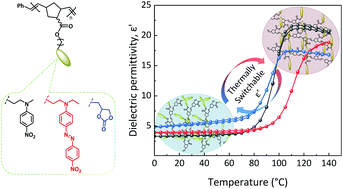Synthesis of polar polynorbornenes with high dielectric relaxation strength as candidate materials for dielectric applications†
Abstract
Materials with high dielectric permittivity and dielectric relaxation strength are sought for thermal and pressure sensors and electrical energy generators. However, most polymers have either too low dielectric permittivity or are so polar that their glass transition temperature (Tg) is too high and thus decomposition and side reactions occur before an electric field can polarize the polar groups. Here, we use the power and versatility of ring-opening metathesis polymerization (ROMP) to synthesize polar polymers with high dielectric relaxation strength and Tg significantly below the decomposition temperature. We first synthesized six polar norbornene monomers by conventional esterification, which were then polymerized by ROMP using Grubbs first- and third-generation catalysts. The structure of the polynorbornenes obtained were verified by multinuclear NMR spectroscopy, molecular weights determined by gel permeation chromatography (GPC), and thermal properties evaluated by thermogravimetric analysis (TGA) and differential scanning calorimetry (DSC). Additionally, their dielectric permittivity, conductivity, and dielectric losses were measured at different temperatures and frequencies ranging between 0.1 and 106 Hz.



 Please wait while we load your content...
Please wait while we load your content...